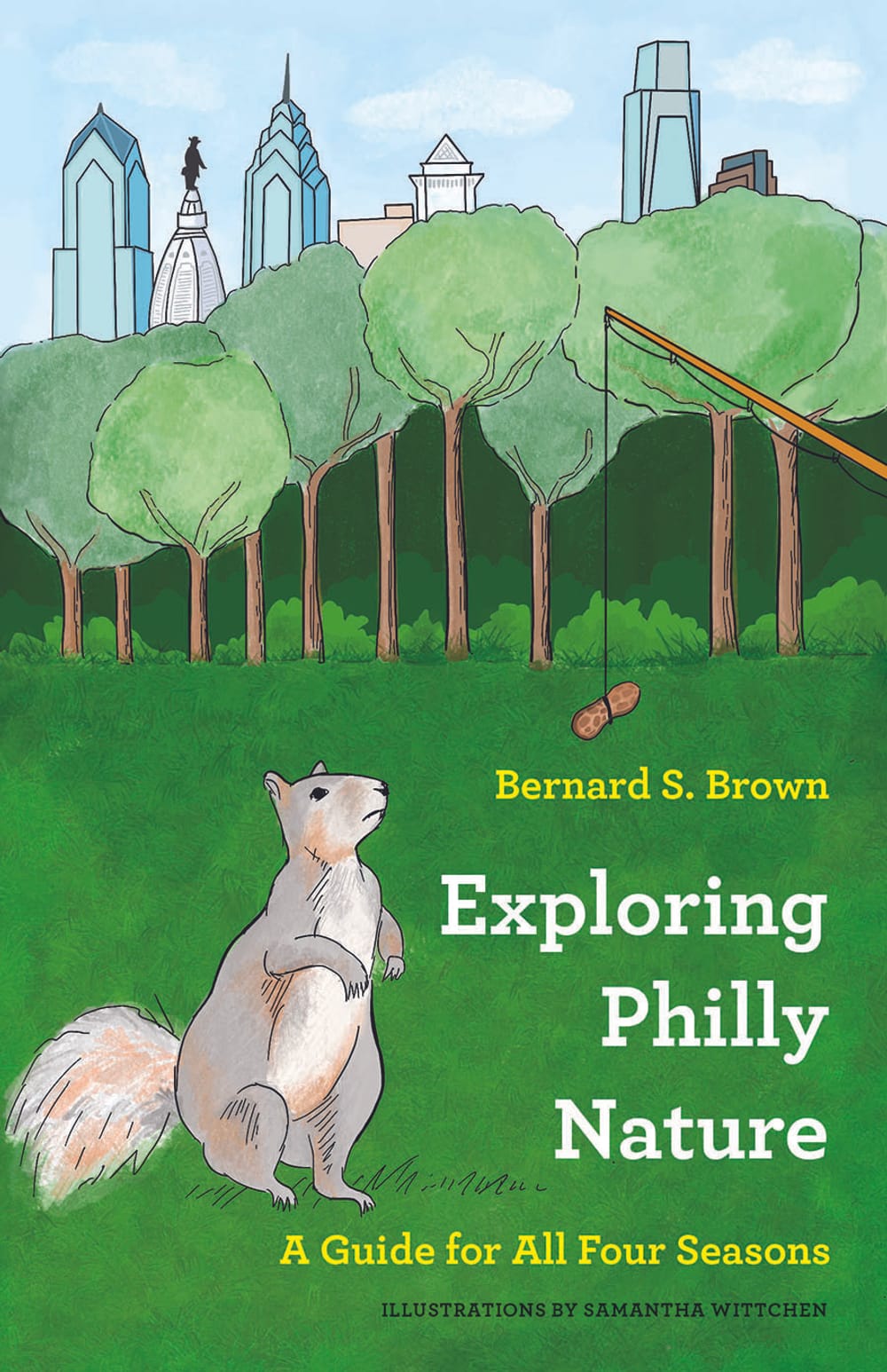Stay in the Loop
BSR publishes on a weekly schedule, with an email newsletter every Wednesday and Thursday morning. There’s no paywall, and subscribing is always free.
The wild things are here
Exploring Philly Nature: A Guide for All Four Seasons, by Bernard S. Brown

The cover says it all: a squirrel, quizzically eyeing a peanut on the end of a fishing line. In Exploring Philly Nature, Bernard S. Brown lures oblivious city-dwellers into noticing the nature that surrounds us. We are the squirrel, nature the peanut.
Samantha Wittchen’s illustration depicts squirrel fishing, one of the nuttier suggestions in this engaging guide. Brown writes that when he tried it, “I got the critter off the ground—the goal of squirrel fishing—dangling by its front paws for a second before it chewed a hole in the shell, got its prize, and let go.”
Choose your adventure
With childlike wonder and enthusiasm for all things icky (“Dead Zombie Fly Patrol,” p. 96; “Slime Mold Search,” p. 78), Brown catalogs strategies to encounter nature in every season. Fortunately, most do not involve dead or slimy things. For many, you need nothing more than to be curious and observant.
You can walk, sit, cycle, or paddle. Take in trees, birds, bugs, or whatever tiptoes by in the night. No matter how squeamish you are, inexperienced, physically fit, cash-strapped, or dubious, there are adventures to suit.
Brown, who writes for the local environmental magazine Grid, cohosts the Urban Wildlife podcast, and cofounded phillynature.org, lists activities by season. Each description includes bulleted details on locations, necessary equipment, guided versions of the activity, appropriateness for children, and resources for more information.
Nature in the house
The point of Exploring Philly Nature is to draw attention to plants, animals, and processes that exist everywhere, even indoors. “In every human home,” Brown writes, “animals find a way to live … consider [your basement] to be a cave and explore it with a flashlight, searching for the spiders, crickets, and other arthropods adapted for darkness … If you have no basement, take a look behind furniture and along windowsills for spiders spinning webs to catch unlucky flies, beetles, and moths.” (Let’s pretend this recommendation is followed by permission to relocate the menagerie with a friendly dust cloth.)
Celebrate summer by holding a moth night. All that’s needed is a light source (to attract) and a white sheet (for landing). Plan a backyard stakeout to see what ambles through after sunset. The only requirement is to be still and quiet, so as not to startle visiting opossums, raccoons, deer, foxes, or even coyotes. Timid naturalists might prefer the subtle sparkle of midsummer fireflies. Brown reports that even these gentle creatures promise drama: “Females of some species even imitate the flashing patterns of others so they can eat the males they lure in.”
Nature in repose
Cemeteries are excellent places to encounter nature. Brown inspects weathered headstones for varieties of lichen, explaining, “Every lichen is a ‘composite organism.’ A fungus provides the structure, and an alga grows within it and conducts photosynthesis, essentially feeding the fungus in a mutually beneficial relationship.”
Two of Philadelphia’s oldest graveyards combine history with nature. At the Woodlands in West Philadelphia, summer evening walks may include the sight of bats taking flight to feed on insects. Laurel Hill Cemetery, perched just over Kelly Drive, offers events year-round.
Go birds
Most of us have watched birds, if only casually, but Brown reveals how fascinating it can be. Spring through fall, standing on the sidewalk almost anywhere in the city, it’s possible to catch sight of chimney swifts fluttering, swooping, and dive-bombing into old chimneys as they return to nesting young.
From winter to early spring, bald eagles can be found tending eaglets in huge nests at the mouth of Pennypack Creek in northeast Philadelphia, or John Heinz National Wildlife Refuge at Tinicum.
Peregrine falcons are in evidence in places that most resemble rocky cliffs. Locally, that includes Philadelphia’s City Hall, the Delaware River bridges, and St. John the Baptist Catholic Church in Manayunk. For convenient viewing of St. John’s peregrines, Brown recommends the Couch Tomato Café across the street. Each June, the Delaware Valley Ornithological Club sets up at that location for the view.
Whether we take a walk in Tacony or cycle the Wissahickon, press wildflowers in Queen Village or tap maple trees in Cobbs Creek, Philadelphians don’t need to get back to nature. We need only recognize we’re already there.
What, When, Where
Exploring Philly Nature: A Guide for All Four Seasons. By Bernard S. Brown, illustrated by Samantha Wittchen. Philadelphia: Temple University Press, July 22, 2022. 168 pages, softcover; $17.95. Get it from Temple University Press.
Sign up for our newsletter
All of the week's new articles, all in one place. Sign up for the free weekly BSR newsletters, and don't miss a conversation.